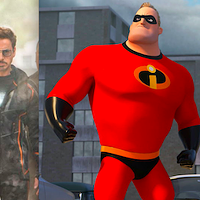Tuesday, December 14, 2010
News The 3-D Effect: Are 3-D TVs bad for your eyes?
Posted By Web Editor on Tue, Dec 14, 2010 at 4:55 PM
When I was a lad, ax-wielding Jason Vorhees squeezed a man’s head so hard, an eyeball shot off the silver screen. And Jaws III got so close, you could smell the chum on his breath. Today, Jigsaw is scaring a new generation of moviegoers in 3-D.
Audiences have been jumping in their seats for decades thanks to the 3-D effect on the big screen. (Although I gotta say it didn’t do much for Hitchcock’s Dial M For Murder.) But now that millions of Americans are inviting 3-D TVs into their own living rooms, I’m wondering: Could prolonged 3-D viewing do more actual eyeball damage than Voorhees?
I’ve been asking myself that question ever since my best friend — a stereoscopic compositor of 3-D imagery with Hollywood film credits including Avatar and Clash of the Titans — told me not to let my 1-year-old watch his movies. Why? He said it might screw with development of depth perception.
In an age where many Americans probably spend a few hours daily facing off with a computer screen, his warning could be as obsolete as my mom telling me not to sit too close to the TV or I’d end up cross-eyed. Until millions of Americans are falling asleep every night with 3-D glasses on, we can’t be certain of the long-term effects. That research is, however, already underway.
About 650,000 3-D TV sets shipped in the U.S. through September and that number is expected to surpass 1 million by year-end, according to the Consumer Electronics Association.
Clearly 3-D TV isn’t for everyone. That is, the 3-D image isn’t clear for some people even when they're wearing the magic glasses. And a warning posted on electronics manufacturer Samsung’s website advises that some viewers could experience eye strain, dizziness, nausea and headaches while watching 3-D TV. And a CBS-TV executive was recently quoted, saying as many as 30 percent of people won’t enjoy 3-D TV because of visual difficulties. Genia Beasley, a developmental optometrist with All Ages Vision in Charlotte, said that number could be closer to 50 percent.
If your eyes aren’t already crossed, 3-D TV probably won’t bother you any worse than regular TV, according to Beasley and Phil Bugaiski, a developmental optometrist with Development Vision Center in Charlotte. But if your eyes are misaligned or one eye is weaker than the other, you could be one of many people who don’t enjoy 3-D imagery or don’t see the effect at all, Beasley and Bugaiski said.
Getting the 3-D effect requires precise teamwork between the eyes, focusing on two separate images at the same time to create the illusion of depth. If the eyes aren’t working together in stereoscopic harmony, the viewer won’t see the effect properly.
Before you purchase a 3-D TV, Beasley said you might want to take in a two-hour movie with the family. A 3-D TV might look cool for five minutes in a store showroom, but after two hours, your eyes might not be able to hold the image together, she said.
If a child is uncomfortable with 3-D viewing, that’s a red flag for possible vision problems that could also hinder reading, academic and athletic performance, Bugaiski said. But even if you have problems with 3-D imagery, you don’t have to take that TV off of layaway yet. With corrective lenses or therapy, many people are able to realign their vision.
After that, you can watch 3-D TV in moderation and the only eyeballs you have to worry about are the ones that Voorhees launches at you.
— Daniel Jackson
Speaking of...
Comments (2)
Showing 1-2 of 2
Latest in The CLog
More by Web Editor
-

Charlotte Talks about summer movies
Jun 12, 2018 -

Charlotte Talks About Oscar
Feb 22, 2016 -

Charlotte Talks about summer flicks
Jun 11, 2015 - More »










